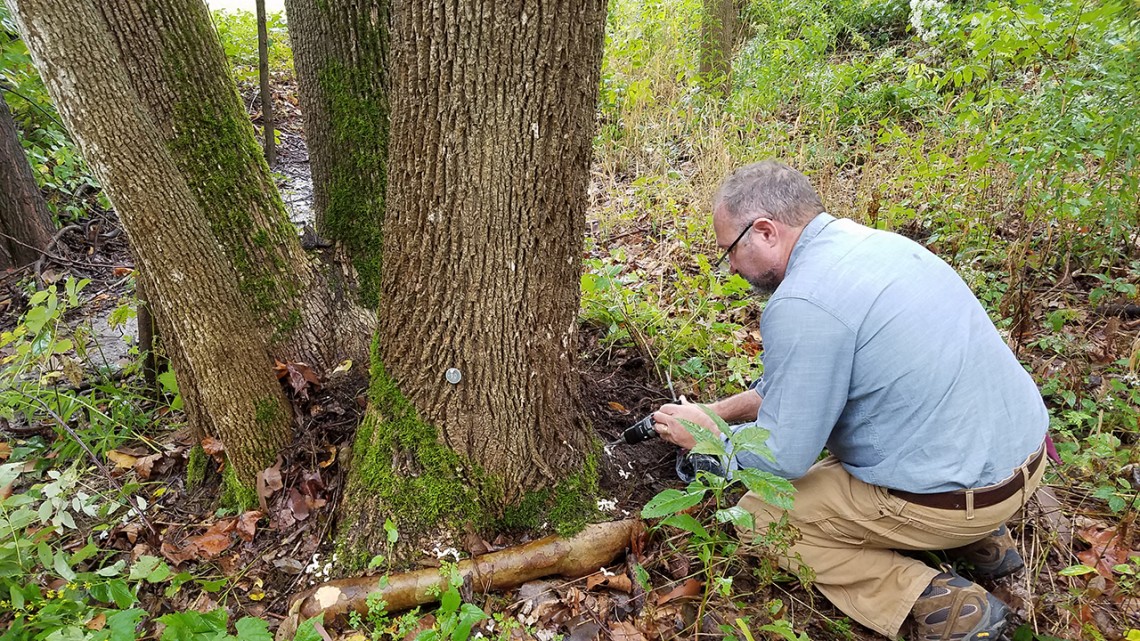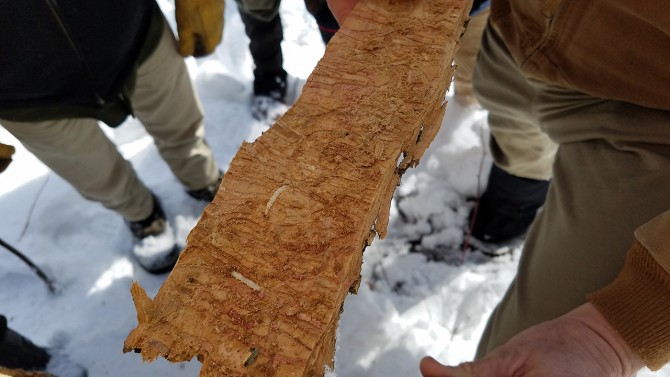
Joe Doccola, ’79, injects an ash tree in the Mundy Wildflower Garden with pesticide to prevent infestation by Emerald Ash Borer larvae. Doccola is director of research and development for Arborjet.
Treatments give campus ash tree protection a limb up
By Shannon Dortch
Cornell Botanic Gardens treated some 50 priority ash trees within campus natural areas this fall in efforts to manage emerald ash borer (EAB), an invasive insect that decimates ash forests.
Trees were chosen for treatment based on their size, location relative to buildings and trails, and their condition and health, as well as for their ecological value, said Todd Bittner, director of natural areas for Cornell Botanic Gardens. Treated trees are in the areas of Beebe Lake, Mann Library Slope, Fall Creek South, Slim Jim Woods (in the F.R. Newman Arboretum) and the Mundy Wildflower Garden.
The treatments were donated by Arborjet, maker of tree pesticide injection technology, and employ a widely used pesticide for controlling EAB infestation. Treatments typically protect trees for two to three years. Joe Doccola ’79, the firm’s director of research and development, oversaw the treatments.
The largest tree protected by treatment is a majestic ash located in the Mundy Wildflower Garden. At more than three feet in diameter, the tree is significant in its own right, and also hosts a large honey bee hive.
“Literally thousands of bees populate the hive; you can smell honey while standing next to the tree,” Bittner said. “Bees such as those that inhabit this and other ash trees pollinate the plants that sustain us and nature. Saving the tree helps save bees and the ecosystem services they provide.”
Cornell Botanic Gardens is collaborating with university units and colleges – such as the College of Agriculture and Life Sciences, Grounds, and Facilities – to assess and manage EAB risk to an estimated 2,600 on-campus ash trees. The Botanic Gardens is also protecting 43 ash trees from across North America located in the F.R. Newman Arboretum. Additional efforts to inventory ash trees and develop removal plans for the majority of them are also underway.
The highly invasive EAB is a bright metallic green beetle that feeds and breeds exclusively on ash trees. A native of Asia, EAB has killed millions of trees in the U.S. and Canada since its discovery in 2002, and is regarded as one of the most destructive forest pests in North America. It was detected on the Cornell campus in summer 2018, where it had attacked ash trees in Cornell Botanic Gardens’ arboretum.
Shannon Dortch is associate director of communications and marketing at Cornell Botanic Gardens.
Media Contact
Get Cornell news delivered right to your inbox.
Subscribe
